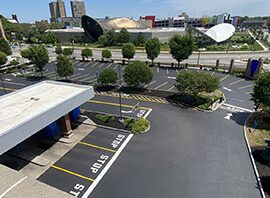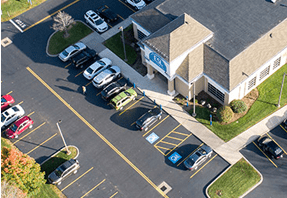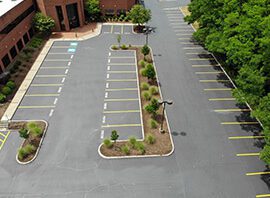Mar 28, 2025 | 1-800-Striper St. Louis
St. Louis is a city in constant motion. In 2024, the region’s 20 largest construction projects reached a combined value of $20.3 billion, marking a 28% increase from the previous year.
Simultaneously, the city is set to host 974 impactful events in the next 90 days, with a predicted attendance of over 2.3 million people and an estimated event-related spending of $165 million.
This dynamic environment of continuous infrastructure development and public gatherings necessitates effective solutions to manage the ever-changing urban landscape.
Temporary striping is a vital tool in this context, providing the flexibility to adapt to shifting needs. It offers clear guidance in spaces that are in flux, maintaining order amidst the city’s bustling activities. Temporary striping helps manage traffic flow and minimize road closures during events and construction projects.
In this guide, we’ll explore how temporary striping helps manage events and construction projects in St. Louis. From maintaining safety and compliance to adapting to a changing landscape, the right striping strategy makes all the difference.
Some projects don’t need permanent paint, but they do need structure.
That’s where temporary striping comes in. It’s the fast, flexible way to organize spaces, direct traffic, and keep things running smoothly, whether for a one-day event or a months-long construction site. Unlike permanent road markings, these lines are made to disappear when they’re no longer needed.
Temporary striping is typically applied using specialized paints, spray chalk, durable tapes, or pavement marking tape. The choice depends on how long the markings need to last and how easily they must be removed.
Pavement marking tape can be used immediately after application, minimizing road closures. For high-traffic areas, reflective materials help improve visibility, while non-reflective options work just fine for spaces that only need daytime guidance.
The best part is the flexibility. Temporary striping can be adjusted to fit any space, whether marking out parking lot spots for a festival, setting up detour lanes around a construction zone, or creating pedestrian walkways to keep people safe.
When the event wraps up or the work is done, the markings come off clean, leaving no trace behind.
Events bring energy, excitement, and — without the right planning — chaos.
From parking nightmares to bottlenecked entrances, a lack of organization can frustrate guests before they even enter the gate. That’s where temporary striping comes in. With proper markings, everything flows smoothly, keeping crowds moving and event spaces functional.
Big events mean big crowds, and without clear direction, things can quickly turn into a free-for-all. Temporary striping helps create order by mapping out parking areas, guiding foot traffic, and designating specific zones. A well-marked layout prevents confusion, gets people where they need to go, and will decrease the number of high-traffic spots.
At festivals, temporary striping can mark designated parking areas and VIP sections while keeping fire lanes clear. At a stadium event, it can help manage pedestrian walkways and vehicle lanes so that fans don’t wander into busy areas, especially during heavy traffic.
Even something as simple as food truck lines can benefit from proper striping, keeping crowds organized instead of clustering into an unmanageable mob.
Managing traffic at events means managing every moving part — vehicles, pedestrians, and emergency access routes. Without a plan, event traffic backs up, frustrates attendees, and even creates safety risks. Temporary striping prevents that by keeping everything moving in the right direction.
Temporary pavement marking tape helps guide cars into and out of parking areas without unnecessary delays. Clearly marked drop-off zones mean ride-share drivers don’t clog up main roads. Emergency access lanes stay visible so first responders can reach the scene without pushing through a crowd.
The bottom line: When traffic has a plan, everything runs more efficiently.
Most events are temporary, so why invest in permanent markings? Well, let’s talk about it.
Temporary striping provides all the benefits of professional traffic management without the long-term cost. Instead of spending money on permanent solutions that need to be removed later, event organizers can get high-quality markings for exactly as long as they need them — no more, no less. Temporary striping can also be removed in large pieces, making cleanup quick and easy.
A charity race might need pedestrian lanes and start/finish markers for a single day. A weekend festival might require temporary parking spots and pathways to keep people moving. Whatever the situation, temporary striping offers a cost-effective, professional solution without the commitment of permanent paint.
Outdoor events don’t wait for perfect weather, and neither should your striping. The right materials stay visible rain or shine, providing clear direction no matter the conditions. Whether it’s a sudden St. Louis thunderstorm or the beating summer sun, temporary striping holds up when it matters most.
Construction sites are constantly changing. One day, a stretch of road is open; the next, it’s blocked off for excavation. Without clear direction, these environments can become confusing — and dangerous.
Temporary striping brings order to the chaos, guiding workers, vehicles, and pedestrians safely through evolving worksites.
Every construction site needs structure, and not just in the buildings going up. Temporary striping establishes clear boundaries, designates work zones, and creates safe pathways for foot and vehicle traffic on various surfaces, including concrete and asphalt.
It’s the difference between a well-run site and one where workers, delivery trucks, and pedestrians second-guess where they should be.
Regulations exist for a reason, and temporary striping plays a big role in safety standards at construction sites. Marking hazardous areas, temporary barriers, and equipment zones on asphalt and other surfaces reduces the risk of accidents and complies with local and federal guidelines.
Without clear markings, workers and drivers may misjudge distances, wander into restricted zones, or fail to see active work areas. It’s a simple but effective way to minimize risk and keep worksites as safe as possible.
Construction projects evolve, and so do their layouts. What was a traffic lane yesterday might be a work zone tomorrow. Temporary striping is flexible enough to change as needed, keeping markings aligned with the latest site conditions.
Rather than relying on outdated or unclear signage, fresh striping confirms everyone on site stays informed. When traffic patterns shift, pedestrian paths are rerouted, or new hazard zones appear, temporary striping keeps safety and efficiency at the forefront.
A busy construction site is a revolving door of workers, delivery trucks, and inspectors. Without clear markings, navigating the site becomes a guessing game. Temporary striping eliminates confusion, providing clear, visual guidance for everyone arriving on site.
Parking areas for construction workers mean vehicles don’t clog up active work zones. Designated delivery routes help truck drivers avoid restricted areas and get materials where they need to be. Visitor pathways keep people away from dangerous equipment and moving machinery.
St. Louis is always on the move. Whether it’s a packed stadium for a Cardinals game, a downtown festival, or another major construction project, the city’s landscape is constantly shifting. Without clear direction, traffic can back up, pedestrians can get lost, and work zones can become hazards. Temporary striping keeps everything flowing, providing structure in spaces that need flexibility.
Mardi Gras, baseball games, concerts—St. Louis hosts major events year-round. Without proper markings, parking turns chaotic, foot traffic clogs up, and emergency access is at risk. Temporary striping provides structure, directing vehicles and pedestrians with ease.
At the same time, constant construction means roads and sidewalks are always changing. Striping helps manage detours, work zones, and lane shifts, keeping drivers, workers, and pedestrians safe.
Construction routes change daily. A parking lot becomes a festival venue overnight. Permanent markings don’t work in a city that never stops evolving, but temporary striping does—providing flexible solutions that adjust to shifting layouts.
Certain times of the year bring massive crowds to St. Louis. Baseball season, street fairs, and big events flood the city with traffic. Without a plan, parking, walking paths, and vehicle lanes become messy. Temporary striping keeps everything clear, cars moving, and pedestrians safe.
In a city that never slows down, temporary striping is the key to keeping events and construction projects safe, efficient, and well-organized.
Not all temporary striping is the same. Each project requires markings tailored to the situation, from festival parking lots to construction detours.
Big events mean big crowds, and without a plan, parking turns into a mess. Temporary striping helps designate parking spots, VIP sections, and drop-off areas, preventing last-minute confusion. Clearly marked traffic lanes keep vehicles moving efficiently without unnecessary delays.
Events and construction sites aren’t just for vehicles — pedestrians need clear, safe routes, too. Temporary striping marks walkways that guide foot traffic around hazardous areas, keeping people out of work zones and away from moving equipment.
At concerts, fairs, and stadium events, these markings create designated walking paths, reducing congestion and improving safety.
Construction sites require constant adjustments, and temporary striping on temporary pavement helps manage shifting traffic patterns. Lane markings direct vehicles safely around roadwork, while closures and detour indicators inform drivers.
Within work zones, striping marks off equipment areas, loading zones, and staging sites so both workers and visitors know where they need to be.
Some projects require more than just standard lines. Temporary striping can also mark emergency access lanes, loading docks, staging areas, and restricted zones.
Whether keeping vendor trucks organized at a festival or confirming that emergency vehicles can move freely, customized striping solutions provide the proper guidance for any situation. Yellow temporary striping is particularly effective for high-visibility markings in construction and event settings on road surfaces.
No matter the event or project, temporary striping keeps things running smoothly by providing clear direction, improving safety, and adapting to changing needs.
Whether it is an event or a construction site, the quality of temporary striping affects safety, traffic flow, and organization. In a city like St. Louis, where roadwork and public gatherings are common, choosing the right striping service means looking beyond the basics.
St. Louis has a busy calendar of festivals, sporting events, and infrastructure projects. A striping service that understands the layout of the city, its traffic flow, and the demands of different sites will provide better results. A concert venue needs a different approach than a highway work zone.
A provider with local experience will know how to adjust for each situation.
The weather can be a challenge in St. Louis. Hot summers, heavy rain, and freezing winters all affect pavement markings. A reliable striping service will use visible and intact materials through changing conditions. Paint that fades in the heat or wears off after a storm is not a solution.
Each project has its own requirements. Some sites need bold, high-contrast markings. Others require specific symbols or designated lanes. A good striping provider will tailor markings to fit the event or worksite rather than applying a one-size-fits-all approach.
Construction sites and public event spaces must follow local safety codes. Failing to meet these standards can create hazards or result in fines. A professional striping service will confirm that all markings align with St. Louis regulations, keeping pedestrians, drivers, and workers safe.
Temporary striping is built to last just long enough. Whether it’s guiding traffic at a festival or marking safe zones at a construction site, these lines need to stay clear and visible until the job is done.
The problem is that heavy foot traffic, vehicles, and unpredictable weather can wear them down faster than expected. That’s why you need a maintenance plan to keep everything readable and in place.
Not all markings fade at the same rate. A parking lot entrance, a detour lane, or a pedestrian walkway will see more wear than a quiet corner of the site.
Regular inspections help catch problems before they confuse people. Fresh striping or the use of durable and easy-to-maintain temporary pavement marking tape in high-use areas prevents bottlenecks and safety risks.
Striping should hold up under normal conditions, but in a busy setting, some fading or scuffing is unavoidable. A touch-up should be quick and effective. It should not interrupt traffic flow at an event or delay work on a job site. The best striping solutions allow for easy reapplication without disrupting the schedule.
Rain, humidity, and temperature swings affect how well striping adheres. A heatwave can cause paint to dry too fast. A storm can wash it away before it sets. As such, timing matters.
Your provider should check the forecast and choose the right materials for the conditions. This makes a big difference in how long the markings stay in place.
Temporary striping is only useful if it stays visible. A little care helps the markings remain clear, effective, and reliable until they are no longer needed.
Cities are living things. Streets shift, buildings rise, and crowds gather in waves, filling spaces that were empty the day before. Without structure, things can get messy.
Temporary striping marks pavement and creates flow where there is none, shaping the movement and making sure that progress — whether a celebration or a construction plan — happens smoothly and safely.
If you are planning an event or managing a construction project in St. Louis, trust a team that understands how to bring clarity to shifting landscapes. Let’s create a space that works — beautifully, efficiently, and with purpose.

Had our parking lot paved and found ourselves needing lines. Their team was fantastic from start to finish. They took the time to give great advice and listened closely to our company’s needs.

They are very responsive and complete the work in a timely fashion. I have used them for 18 years and have never had any issue with their work. Very highly recommended.

They are very easy to work with and have a highest level of attention to detail. They are very knowledgeable and passionate about parking lot striping. Their quality of work is outstanding!
COPYRIGHT © 1999-2025 | ALL RIGHTS RESERVED STRIPER INDUSTRIES, INC. | Privacy Policy | Powered by Bon's Eye Marketing